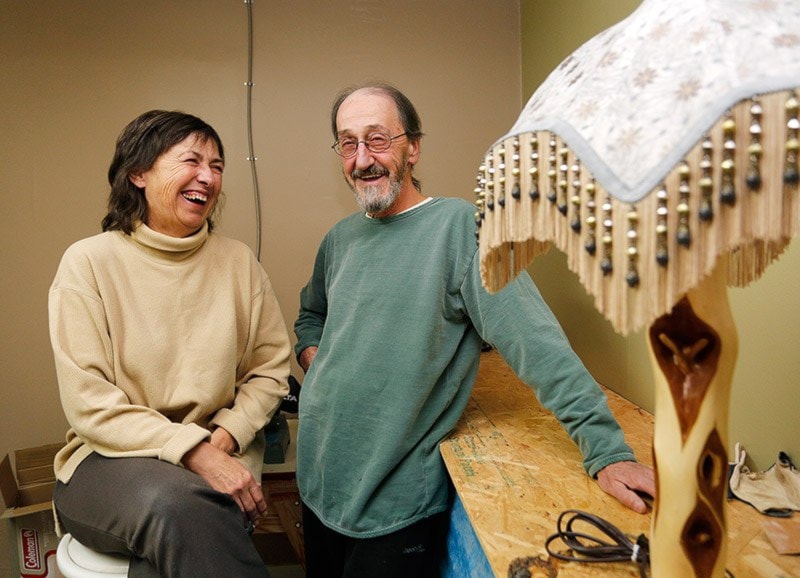Artistic inspiration can come from the strangest of places.
Lucy Moreira and Rick Charlebois run Lone Wolf Creations, a small Faro home-based business where pieces come together with time, patience, fungus and occasionally a little bit of dung.
The couple are the first to admit they’re not the greatest at self-promotion, but it appears they’re happy that way.
He builds everything from candlestick holders to tables and lamps out of diamond willow wood. She’s currently focused on lampshades and jewellery but once spent her time make journals out of paper that included moose or sheep dung.
“We’re not good at advertising. I always thought if we were better at advertising that we could go further, but then you think, how much further do we want to go, really?” Moreira said.
The couple create and sell their work in the winter so they can spend their summers camping, fishing and enjoying their home in Faro.
“For myself, I wouldn’t want to be any busier than I am because I only do it in the winter and even then it just takes too much time,” Charlebois added.
Diamond willow is found growing all over the Yukon. It’s primarily a light wood that includes dark brown “diamonds” created when a fungus attacks the tree.
Charlebois has a pile of wood sitting in the corner of his basement. Diamond willow takes patience. Some pieces need to dry for as long as six years before they are ready to be worked with.
After Charlebois finds a piece of wood he likes he’ll bring it home and cover each end with a wax emulsion. That controls how fast the moisture leaves the wood, he said.
He’ll then peel back the bark from the light areas, leaving the dark “diamonds” covered.
“The bark is sort of like birch where it doesn’t breathe,” he said.
“So if you leave the bark on all the moisture goes out the ends and then they split really bad.”
The wood will sit like that for years until it’s ready.
Deciding when to move on to the next step is not an exact science but, after 30 years of working with this type of wood, Charlebois can tell by how much the wood weighs.
“They’re really heavy when they’re green.”
Taking the bark off the diamonds is slow and steady work. Charlebois uses a small Dremel tool on the diamonds and sands the white wood with a palm sander.
“Some people use knives and chisels,” he said. “But then you cut through the grain and it doesn’t look very nice.”
Larger pieces, like the plant stand in his house, can take up to 20 hours.
“Until a few years ago I used to look it up on the internet, do image searches on diamond willow, and I saw some pretty ugly stuff,” he said.
“People just don’t take the time or the patience to work it properly. If you do a quick job it looks rough.”
A few years ago Charlebois wrote a how-to book on the subject.
On some of his pieces the fungus has decided to get a little more creative.
Charlebois has one long narrow piece where the fungus has wrapped itself all the way around the wood in a spiral pattern from bottom to top.
The resulting wood looks a little like a staff Gandalf would be comfortable carrying.
He hasn’t decided what to do with that one yet.
“It’s the fungus I guess, just the way it attacked this particular tree.”
Sometimes Charlebois’ creations are used as bases for the lamps Moreira makes shades for.
She’s been making lampshades for more than 15 years.
Moreira buys the large sheets of paper for her lampshades. But it was that work that led to a more unconventional technique to make journals.
While looking online for paper to use on lampshades she came across a product made with elephant dung and started thinking.
“We’re walking through the bush and I see moose poop and I think, ‘Oh, why couldn’t I make paper with that?’”
Following some research and trial and error Moreira came up with a way to incorporate moose or sheep dung into paper pulp and make paper of her own.
“It adds a nice fibre to it. I like the look of it, the texture of it, it’s a little bit rugged.”
Dung is not difficult to find in Faro. Aside from moose, the community is home to a well-known herd of Fannin’s sheep.
“And then people bring me lots of poo,” she said, laughing.
Moreira collects the dung and boils it for a few hours. She then kneads it with her hands to pull apart the fibres and boils it a second time.
“All you want left is the fibres from what they’ve been eating,” she said.
She freezes what’s left so it’s ready to be added to the pulp whenever she needs it.
Moreira made journals this way for about four or five years but stopped a few years ago after “it became more like a job.”
“I was making the same types of journals and there really wasn’t too much creativity going on there.”
There is still a former ice cream tub, half full of moose dung, in her freezer.
She said she’s already thinking of going back to the dung paper, maybe using it to create things other than journals.
For now Charlebois and Moreira are clearly happy with the business they’ve built, creating when they can and selling locally or online when the opportunity presents itself.
“It’s nice that we are able to create things over the winter for the most part and then we can sell them,” she said.
“That means we can create more the following winter.”
For now the couple’s Etsy shop is closed until they create more stock. Anyone interested in the company can reach them at: ricklucy@northwestel.net.
Contact Ashley Joannou at ashleyj@yukon-news.com
